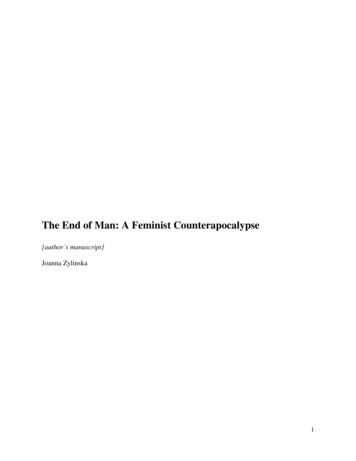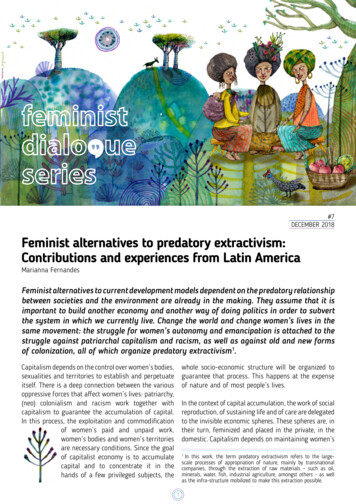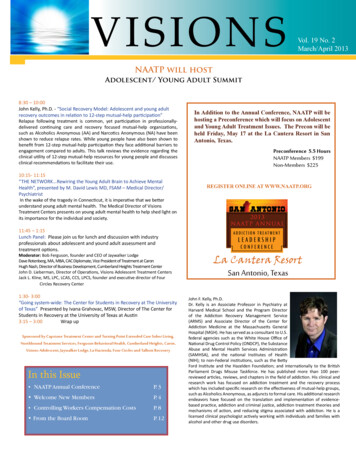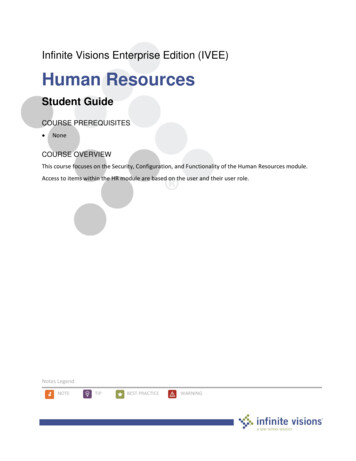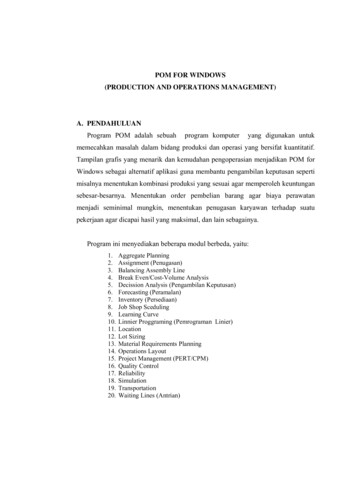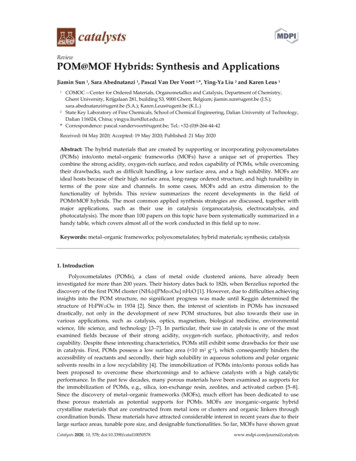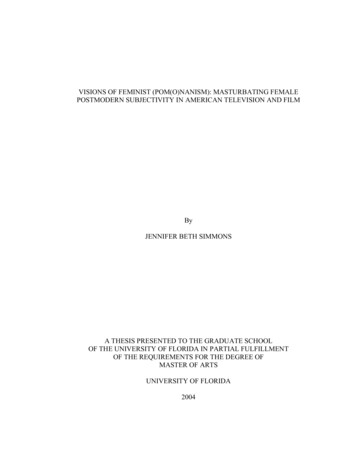
Transcription
VISIONS OF FEMINIST (POM(O)NANISM): MASTURBATING FEMALEPOSTMODERN SUBJECTIVITY IN AMERICAN TELEVISION AND FILMByJENNIFER BETH SIMMONSA THESIS PRESENTED TO THE GRADUATE SCHOOLOF THE UNIVERSITY OF FLORIDA IN PARTIAL FULFILLMENTOF THE REQUIREMENTS FOR THE DEGREE OFMASTER OF ARTSUNIVERSITY OF FLORIDA2004
Copyright 2004byJennifer Beth Simmons
ACKNOWLEDGMENTSI would like to thank Dr. Maureen Turim and Dr. Roger Beebe for their guidancethroughout this project. My sincerest gratitude also goes out to Kate Casey-Sawickiwhose personal and professional support made my work possible and presentable.Humble thanks are also due to all those kind souls in the English Department at theUniversity of Florida who have suffered through listening to all of my mentallymasturbatory meanderings.iii
TABLE OF CONTENTSpageACKNOWLEDGMENTS . iiiABSTRACT.vCHAPTER1INTRODUCTION .12POSTMODERN FEMINISM OR FEMINIST POSTMODERNISM?.43FROM THE FREUDIAN VAGINA TO THE LESBIAN CLITORIS .74MAINSTREAM MASTURBATION MEDIA.125TELEVISING MASTURBATION .166SEINFELD: “MASTERS OF THEIR DOMAINS” AND THE “QUEEN OFTHE CASTLE”.247POSTFEMINIST PROBLEMS AND POSSIBILITIES .288SEX AND THE CITY: MASTURBATING “SOUL MATES” .329MASTURBATING THE MOVIES .3810 SINGLE WHITE FEMALE: “I NEVER MET ANYONE SO AFRAID OFBEING A (MASTURBATOR)”.4111 MULHOLLAND DR.: “THIS IS THE (MASTURBATING) GIRL”.5512 CONCLUSION: MASTURBATING FICTIONS FOR CYBORG MYTHSTHROUGH FEMINIST (POM(O)NANISM).75LIST OF REFERENCES.79BIOGRAPHICAL SKETCH .83iv
Abstract of Thesis Presented to the Graduate Schoolof the University of Florida in Partial Fulfillment of theRequirements for the Degree of Master of ArtsVISIONS OF FEMINIST (POM(O)NANISM): MASTURBATING FEMALEPOSTMODERN SUBJECTIVITY IN AMERICAN TELEVISION AND FILMByJennifer Beth SimmonsMay 2004Chair: Maureen TurimMajor Department: EnglishThis project explores the possible literal and theoretical significance of femalemasturbation as a model for negotiating a progressive personal and political relationshipbetween feminism and postmodernism. Masturbation seems to represent a potent form ofsexuality, yet one that is not essentially defining or definitely essential. In a postmodernworld where identity and sexuality are unstable and fluid, masturbation in its nebulosityseems strangely appropriate and as such potentially relevant for better understandingpostmodern existence and women’s postmodern existence in particular. Despite, andindeed because of, its somewhat troubled history, female masturbation might provide akind of touchstone for exploring the nature of feminist postmodern subjectivity. The selfserving and self-critical sexuality of masturbation in practice and in its representationwithin televisual and filmic sites of cultural impact seems particularly useful as a point ofinitiation of this kind of committed exploration.v
In looking at the prospect of female masturbation in Seinfeld, Sex and the City,Single White Female, and Mulholland Dr. we can begin to imagine the framework andpotential of this kind of theoretical and political tool. Female masturbation in these textssignifies sexual power and freedom, lesbian continuum community building, queertransgression of heterosexist norms, feminist agency, recuperative confrontation withpsychic trauma, and salient subjectivity integration. Combining second wave and postfeminisms, postmodernism, queer theory, and psychoanalysis, an understanding of thepotency of masturbation promises to offer new progressive ground for both individualand collective satisfaction and action. If we work practically and theoretically to embracea kind of feminist (pom(o)nanist) subjectivity and wield its powerful benefits socially,then we might be able to move towards actualizing a kind of radical, eroticized utopia.vi
CHAPTER 1INTRODUCTIONNo sexual practice over the past three hundred years has signified quite so much, in quiteso many places, to quite such a range of people --Thomas W. Laqueur, Solitary Sex: ACultural History of MasturbationWhen I was a child the Mormon church told me that masturbation means a gatewayto deviant homosexuality and spiritual ruin; when I was an adolescent a YM magazinetold me that masturbation means sexual experimentation; when I was a young adult mymother told me that masturbation means a way to help husbands learn how to help wivesenjoy sex. These are just a few of the things that masturbation has signified in my life, yetnone of them seem quite right. Now an adult feminist bisexual film studies student tryingto understand gender and sexuality in their postmodern manifestations, I am still trying tofigure out what the “right” signification(s) of masturbation might be.If the above quote is true, then it is no wonder that getting a hold on whatmasturbation is and why it might be significant seems to be so difficult. And if it is truethen it seems that attempting to accomplish such a difficult task is monumentallyimportant when negotiating the terrain of gender and sexuality studies within the forcefield of postmodernism. If masturbation has signified so much in so many places to somany people, then should we not be more concerned with exploring what it means for usnow?What is masturbation? Is it deviant and/or liberatory? Is it personal and/or political?Is it subjective and/or objective? Is it fantasy and/or reality? Masturbation seems to1
2represent a potent form of sexuality, yet one that is not essentially defining or definitelyessential. Laplanche and Pontalis describe autoeroticism as “that moment.whensexuality draws away from its natural object.[and].finds itself delivered over tophantasy,” thereby existing as sexuality itself (46). Eve Kosofsky Sedgwick contendsthat:part of the great interest of autoeroticism.is that it is a long-execrated form ofsexuality, intimately and invaluably entangled with the physical, emotional, andintellectual adventures of many, many people, that today completely fails toconstitute anything remotely like a minority identity. (303)Thus in some ways masturbation is sexuality, is everyone, and is noone. In a postmodernworld where identity and sexuality are unstable and fluid, masturbation in its nebulosityseems strangely appropriate and as such potentially relevant for better understandingpostmodern existence and, I would argue, women’s postmodern existence in particular.According to Laqueur, “history has given female masturbation–liberating, ecstatic,dreamy, and lyrical versus abject, humiliating, and decidedly second-rate–its own,gendered resonance”(406). Despite and indeed because of this somewhat troubledhistory, female masturbation might provide a kind of touchstone for exploring the natureof feminist postmodern subjectivity. Sedgwick similarly argues that:in the context of hierarchically oppressive relations between genders and betweensexualities, masturbation can seem to offer–not least as an analogy to writing–areservoir of potentially utopian metaphors and energies for independence, selfpossession, and a rapture that may owe relatively little to political or interpersonalabjection. (303)At the, I think, vital risk of indulging in written mental masturbation, I would like to hereseek out some answers to the above question of what this unique form of sexualitysignifies and can signify for us now through exploring what these “utopian metaphors”might be exactly.
3By examining the representations and implications of female masturbation in twoof its televisual and two of its cinematic recent manifestations, I hope to suggest that as aliteral and theoretical model, masturbation can create a potentially fecund avenue towardsthinking through postmodern subjectivity, feminist action, sexuality, and the disjunctiveand possibly liberatory relationship between fantasy, desire, and reality.
CHAPTER 2POSTMODERN FEMINISM OR FEMINIST POSTMODERNISM?As E. Ann Kaplan considers in attempting to utilize television studies in elucidatingthe significance of postmodernism and feminism alike, the relationship between thesetwo fields of study remains fraught with troubling complications:Contemporary feminism, as a political and cultural discourse, has assumed a set ofstrategic subjectivities in order to attack the old patriarchal theorists. Feministshave both made use of and criticized the powerful, often subversive discourses ofboth Marx and Freud in creating the feminist stance against dominant genderconstructs. If those discourses are seen as no longer relevant, on what ground canany strategic feminism stand?.Does postmodernism make feminism archaic as atheory, while refusing to address the remaining oppressive discourses thatperpetuate woman’s subordination?(38)As these questions suggest, the unease and potential danger of an alliance betweenpostmodernism and feminism persists despite the basic similarities between theirrespective goals. In fact, in many ways feminism is already postmodern in that it “enter[s]into and echo[s] postmodernist discourses as we have begun to deconstruct notions ofreason, knowledge, or the self and to reveal the effects of the gender arrangements thatlay beneath their neutral and universalizing facades”(Flax 42). As such these two fieldsshould be understood as already interrelated rather than as being distinct categories inspite of their somewhat contradictory foundational principles. While both fields seek todismantle the essentialist and essentializing grand narratives of the Enlightenment thatclaim to provide universal explanations and trade on the authority this gives them, suchas those that constitute traditional gender roles and relations, postmodernism also entailsa decentering of the subject amidst this broader dissolution. Modernity encouraged the4
5notion of the individual subject as a unified self with a central core of unique identity.Within postmodernity, however, this kind of fixed unification of identity is no longerpossible and the individual subject is rather viewed as a process in a continual state ofdissolution. In that feminism necessitates a distinction between male and femalesubjectivity in order for its aims at being a social and political force that strives toimprove the specific conditions of these female subjects to hold ground and be effective,this postmodern conception of the unfixed and thus ungendered subject clearly becomesproblematic for the cause. Consequently, many feminists remain wary of the impact ofpostmodern theory, as Nancy Hartsock articulates by saying:Why is it that just at the moment when so many of us who have been silenced beginto demand the right to name ourselves, to act as subjects rather than objects ofhistory, that just then the concept of subjecthood becomes problematic? (163)This type of suspicion remains palpable even though feminism itself has always beenengaged with a questioning of subjecthood in the form of reevaluating the designation of“woman” and the compulsory norms of “femininity.”Despite these complications, negotiating the interactions of postmodernism andfeminism, particularly in respect to their mutual presence in and relevance for film andtelevision studies, remains essential and can also potentially open up a symbioticrelationship between the two that will help to ameliorate the problematic implications ofeach. Feminism’s attention to the political importance of maintaining some kind ofidentifiable subjectivity helps to prevent postmodernism from becoming a new kind ofdestructive master narrative that does not allow for particular political voices andconcerns. In the reverse relation, postmodernism’s push towards dissolving essentializingand thus limiting gender definitions of what a ‘woman’ or a ‘man’ is “becomes a sort oftherapeutic corrective to feminism’s universalizing tendency” (Thornham 45). In
6conceptualizing this symbiosis, “one can imagine a feminism not only immensely awareof its self-contradiction, but committed to explorations of the contradictions of ‘self’through which the modern social subject is called into being”(Wiegman 13). Film andtelevision present particularly conducive objects of study for such an imagination as theyepitomize sites of prevalent contemporary impact and significance for both feminism andpostmodernism. The self-serving and self-critical sexuality of masturbation in practiceand in its representation within these sites of impact likewise seems particularly useful asa point of initiation of this kind of committed exploration.
CHAPTER 3FROM THE FREUDIAN VAGINA TO THE LESBIAN CLITORISIn the introduction of his 2003 publication concerning the cultural history ofmasturbation, Solitary Sex, Thomas W. Laqueur delineates an overview of society’sevolutionary interpretation of the practice’s significance:The history of masturbation thus goes through three stages although the earlier onesare never left behind.Beginning in the
psychic trauma, and salient subjectivity integration. Combining second wave and post-feminisms, postmodernism, queer theory, and psychoanalysis, an understanding of the potency of masturbation promises to offer new progressive ground for both individual and collective satisfaction and action. If we work practically and theoretically to embrace a kind of feminist (pom(o)nanist) subjectivity and .

